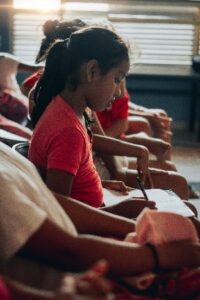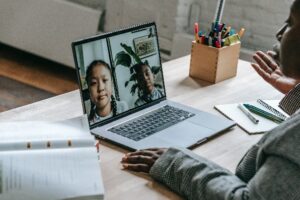What About the Workforce?
By Hal A. Lawson
Nearly every day the news media tells compelling stories about the status of one or more school districts and presents prospects for a return to “school-as-usual”. Three priorities are featured.
First is schools’ essential contributions to children’s learning, academic achievement, social development, and overall well-being. Many stories make it clear that remote schooling driven by online learning and instruction surely has its benefits, but these arrangements fall short of the holistic ones associated with place-based schooling with the full range of customary interactions and behavioral rituals that make up school life. The inescapable reality is that remote schooling driven by and through technologies ushers in challenging problems of educational equity, starting with students’ and families’ available computer technologies and computer literacies, the quality of their internet connections, and teachers’ facility with research-based remote learning pedagogies.
 The second priority might be characterized as “making the invisible, visible.” Here, the reference is to the important, but sometimes invisible roles played by educators and schools for childcare. Childcare responsibilities extend to the broad idea of family support, particularly for parents with jobs. For working parents also tasked with working at home, once-convenient life-work separation is gone with stay-at-home students. Granting the benefits, these new arrangements usually spell stress for working parents also charged with facilitating remote teaching and learning at home. An unknown number of educators are among their numbers.
The second priority might be characterized as “making the invisible, visible.” Here, the reference is to the important, but sometimes invisible roles played by educators and schools for childcare. Childcare responsibilities extend to the broad idea of family support, particularly for parents with jobs. For working parents also tasked with working at home, once-convenient life-work separation is gone with stay-at-home students. Granting the benefits, these new arrangements usually spell stress for working parents also charged with facilitating remote teaching and learning at home. An unknown number of educators are among their numbers.
Enhancing the safety and security of school environments is the third priority. The main question is, what can be done to protect students when they return to their respective buildings? Priorities include sanitizing facilities and equipment, arranging classrooms and configuring schools overall in ways that safeguard social distancing and minimize risky social interactions and potentially adverse environmental impacts.
What’s Missing?
But what about the education workforce? How has the pandemic impacted them? What are their needs and priorities when schooling goes remote or takes on some combination of remote and in-person instruction? What about the special needs of educators with their own school-aged children? What are educators’ emergent needs and priorities when other people make decisions to end remote schooling and bring everyone back to their home buildings? Educators reading this blog surely can add other questions.
Three Kinds of Stress
Workforce research, both field-specific and interdisciplinary, provides convergent findings. Together these findings frame and define important needs, challenges, and opportunities.
Changes in the conditions of work and in the requirements for job performance necessitate cognitive, behavioral, and emotional adaptations as educators make a three-component shift. They are asked to stop prioritizing and doing some things, while they keep doing other things, as well as take on the challenges of new priorities, starting with remote teaching and learning and hybrid forms of both.
Here, the unique and significant part of educators’ performance adaptations cannot be lost from view. These adaptations were not anticipated or planned. They were compelled by dramatic, stressful, and emotionally laden developments associated with the COVID-19 pandemic and the Black Lives Matters movement.
It is safe to say that no one’s job in a school system is the same. While educators’ adaptations overall truly have been heroic, considerable variability in performance adaptations by all manner of educators—teachers, student support professionals, principals, and district office leaders—has been predictable. Meanwhile, the impacts on educators’ work lives, personal lives, and career plans have remained largely off the public’s radar screen.
While the general public justifiably worries about the academic learning experiences and achievement profiles of students, and economists and parents worry about childcare for working families, educators’ needs and emergent challenges merit equal time and attention.
Two such needs and challenges are at the head of the class: (1) educators’ occupational stress—i.e.., perceived job-related demands in the new COVID environment; and (2) the personal-emotional stress that crosses the boundary between work life and personal life.
A third kind of stress is a relative newcomer to education professionals. It is called secondary traumatic stress, and it is associated with emotion-laden interactions with trauma victims—students, parents and other educators. The risks increase as students are impacted by adverse childhood experiences. When parents have been traumatized (e.g., job loss, housing evictions, food insecurities, family member COVID-induced illness or death), they spill their pain on educators, contributing to educators’ secondary traumatic stress.
Weighing Possible Impacts
These three kinds of stress, when combined, form a combustible mix—with consequential impacts on the education workforce. While no one knows what these impacts are, nor have the long-term effects been mapped, the early indicators from the healthcare workforce may provide guidance.
It appears that an unknown number of health care professionals are looking to leave their chosen profession. The changing nature of work, particularly the increasing stress associated with COVID-19 performance adaptations, is a primary driver. An old saying appears to be fit for purpose. Health care workers essentially are saying “this isn’t what we signed up for!”
The same rationale can be applied to educators. Change the conditions of work and require cognitive, behavioral, and emotional adaptations, and it’s highly probable that some educators will look to leave the profession. In support of this loosely-formulated hypothesis, workforce research, sometimes called “occupational (professional) socialization research”, emphasizes key attractors and facilitators for educators’ occupational choices, including preferred roles and behavioral routines. Change them and one result may be workforce turnover, perhaps preceded by other undesirable workforce outcomes such as teachers’ disengagement and principals’ emotional withdrawal from the lives of their colleagues.
Mounting the Workforce Development Agenda
 Clearly the time has arrived to shine a spotlight on the education workforce. There is no shortage of important questions with import for practice, professional education, and policy.
Clearly the time has arrived to shine a spotlight on the education workforce. There is no shortage of important questions with import for practice, professional education, and policy.
Are some educators, like health care workers, looking to leave the profession? Does the turnover impulse vary by role—e.g., teacher, student support professional, principal, other essential workers in charge of transportation, food service, and technology? On the other hand, has the shift to remote learning strengthened their occupational commitments and sparked timely innovations?
Both occupational stress and emotional stress indicate needs for coping strategies and considerable adaptation. Are educators prepared? What have they done? What are the outcomes?
Last, but not least, are educators at risk of secondary traumatic stress? To reiterate, this special kind of stress is associated with interactions with traumatized students and their families, particularly those with mental health needs and behavioral challenges. While the full weight of the needs and challenges arising from the pandemic may not be evident as remote schooling continues, a return to place-based schooling is an entirely different matter. The development of widespread trauma literacy among all manner of educators is essential, and so is the configuration of trauma-informed service systems for the caring adults (educators) whose work exposes them to such mental health risks.
All in all, whatever “return to normal means”, it does not translate to “back to the future.” The education workforce cannot remain a silent partner or taken-for-granted part of the education system. Research and development initiatives, as well as policy advocacy, need to find their ways to the top of the “return to the new normal agenda.”
See other blogs from Dr. Hal Lawson on NYKids’ news page and we always welcome feedback or questions at nykids@albany.edu.
